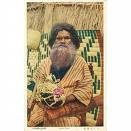. Ezo, Emishi 蝦夷 エゾ Ainu Culture アイヌの文化 .
:::::::::::::::::::::::::::::::::::::::::::::::::::::::::::::::::::::::::::::::::::::::::::::::::::::
Ainu Daruma ... アイヌだるま

This is a present from my friend Ishino.
:::::::::::::::::::::::::::::::::::::::::::::::::::::::::::::::::::::::::::::::::::::::::::::::::::::

Ainu (アイヌ) (also called Ezo in historical texts) are an ethnic group indigenous to Hokkaidō, the Kuril Islands, and much of Sakhalin. There are most likely over 150,000 Ainu today; however the exact figure is not known as many Ainu hide their origin due to racial issues in Japan. In many cases, surviving Ainu may not be even aware of their ancestry, as their parents and grandparents kept their descent private in order to protect their children from social problems.
Their most widely known ethnonym is derived from the word aynu, which means "human" (particularly as opposed to kamuy, divine beings) in the Hokkaidō dialects of the Ainu language; Emishi, Ezo or Yezo (蝦夷) are Japanese terms, which are believed to derive from the ancestral form of the modern Sakhalin Ainu word enciw or enju, also meaning "human". The term Utari (ウタリ) (meaning "comrade" in Ainu) is now preferred by some members of this minority.
© More in the WIKIPEDIA !
:::::::::::::::::::::::::::::::::::::::::::::::::::::::::::::::::::::::::::::::::::::::::::::::::::::
Japan to formally recognize Ainu as indigenous people
Both houses of the Diet unanimously approved a resolution on Friday urging the government to officially recognize Ainu as indigenous people.
The House of Councillors
and the House of Representatives voted in favor of the resolution at their respective plenary sessions on Friday.
On behalf of the executive branch of the government,
Chief Cabinet Secretary Nobutaka Machimura declared that Japan will formally recognize Ainu as indigenous people.
The government is set to establish a panel on Ainu to consider their indigenous rights after it officially recognizes them as indigenous people.
The move will likely represent
a drastic change in Japan's policy of not recognizing Ainu's indigenous rights and putting top priority to the development of Hokkaido where a large population of Ainu has been concentrated since the Meiji Era.
source : Mainichi Shinbun, June 6, 2008
:::::::::::::::::::::::::::::::::::::::::::::::::::::::::::::::::::::::::::::::::::::::::::::::::::::
- - - - - Ainu Food アイヌ料理
. Nibutani Ainu Museum 二風谷アイヌ資料館 .
Nibutani-attus 二風谷アツトウシ cloth
.................................................................................

source : Asahi Gangu Toys
wooden boat with fishermen
The human figures were carved in Sapporo, by
Itazu Kunio 板津邦夫, a famous woodcarver, born 1931.
. . . . .

doll made of woodcarving and cloth

source : Asahi Narumi
from Abashiri 網走 and Asahikawa 旭川
Apart from bears, there are also various types of human beings.
The two bears are made from a special pine, todomatsu トド松 with beautiful wood patterns.

Ainu Kokeshi - from ebay -
. Ainu Folk Toys - Hokkaido .
:::::::::::::::::::::::::::::::::::::::::::::::::::::::::::::::::::::::::::::::::::::::::::::::::::::
Daruma from Enju Wood エンジュ達磨

enju えんじゅ【槐】 is the Japanese pagoda tree, or
Chinese scholar tree.
Styphnolobium japonicum, Sophora japonica
It is a play on words with
long life, enju えんじゅ【延寿】.
The inscription reads:
幸福招く Kofuku maneku (Inviting happiness)
縁寿達磨 Enju (celebrating connection/relationship) Daruma
There seems to be pun on 縁寿 Enju and 槐 Enju tree.
This tree grows widely in Hokkaido.
Styphnolobium japonicum (L.) Schott, the Pagoda Tree
(Chinese Scholar, Japanese pagodatree; syn. Sophora japonica)
is a species of small tree or shrub in the subfamily Faboideae of the pea family Fabaceae.
The tree is is one of the 50 fundamental herbs used in traditional Chinese medicine.
It has abortifacient, antibacterial, anticholesterolemic, antiinflammatory, antispasmodic, diuretic, emetic, emollient, febrifuge, hypotensive, purgative, styptic, and tonic properties.
The Chinese character for the tree (槐) is composed of the parts for
木 ("wood") and 鬼 ("demon").
In folklore, it is said that a cowherd once built a home out of this species of tree, and within a month his entire family was suddenly found dead, with no signs of foul play. It was therefore believed that demons are drawn to this tree and it is therefore not appropriate to use its wood to build homes. In addition, in the wild, other species of trees rarely grow near it.
© More in the WIKIPEDIA !
kigo for early summer
enju no hana 槐の花 (えんじゅのはな) blossoms of the Pagoda tree
..... enisu えにす

葉がくれの星に風湧く槐かな
hagakure no hoshi ni kaze waku enisu kana
wind wells up
from stars hidden behind the leaves -
Pagoda tree blossoms
. Sugita Hisajo 杉田久女 .
:::::::::::::::::::::::::::::::::::::::::::::::::::::::::::::::::::::::::::::::::::::::::::::::::::::
[ . BACK to DARUMA MUSEUM TOP . ]
[ . BACK to WORLDKIGO . TOP . ]
:::::::::::::::::::::::::::::::::::::::::::::::::::::::::::::::::::::::::::::::::::::::::::::::::::::







3 comments:
Ainu museum planned for 2020 to promote understanding of indigenous people
A national museum dedicated to Ainu culture will open in southwestern Hokkaido in 2020 to coincide with the start of the Tokyo Olympic Games.
The museum, in the town of Shiraoi, will focus on the culture of the indigenous population of Japan’s second biggest island as well as promote a better understanding of their history, the Cultural Affairs Agency said July 30, when announcing the basic plan for the museum.
“Representatives of the Ainu people will participate in the selection of the museum’s designers,” said Hiroshi Kamiyo, director of the agency’s Traditional Culture Division. “Because the location of the museum is not far from New Chitose Airport, we plan to install multilingual guidance at the museum, particularly with the view of attracting tourists from around Asia.”
.
http://ajw.asahi.com/article/behind_news/social_affairs/AJ201507310018
.
Legend from Gunma
. enju エンジュ / 槐 Japanese pagoda tree .
鬼門に槐の木を植えると災厄がこないといわれている。
.
https://kappapedia.blogspot.jp/2018/02/kimon-demon-gate-legends.html
.
Saga Tenno 嵯峨天皇 Legends about Emperor Saga
.
嵯峨天皇 Saga Tenno did not like the sound of thunder. He asked Kukai to make it stop.
Kukai advised to plant an enju 槐 Japanese pagoda tree and all the lightning would fall down there.
The master of this tree was shirohebi 白蛇 a white serpent, which should never be touched with a blade.
Once a guardman tried to kill the serpent, but the blade of his sword bent and he soon became quite ill.
.
https://gokurakuparadies.blogspot.com/2020/12/saga-tenno-legends.html
.
Post a Comment